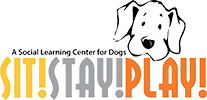Enrichment [en-rich-muh nt] makes something more meaningful, substantial,or rewarding. Enrichment improves something.
Have you ever taken a walk with your dog and waited impatiently as one blade of grass was inspected and sniffed for what seemed an eternity or watch as he stretched his nose into the air independently wiggling each nostril in a different direction? I frequently hear obedience competitors complain that their dogs won’t stop sniffing, or pet owners that suffer from embarrassment as their dog inappropriately assaults guests with their sniffers or lifts another dog’s rear into the air with their muzzle.
We mostly observe the world with our eyes. We watch, observe, and make decisions based on what we see. Dogs rely on their vision too, but because their eyes are anatomically different than ours they accordingly see the world quite differently. A dog’s vision work well for them because they fill a very different environmental niche than humans. A good reference on vision in dogs is http://redwood.berkeley.edu/bruno/animal-eyes/dog-vision-miller-murphy.pdf . Another review of vision in dogs is http://www.eyevet.ca/coile1.html .
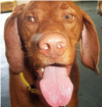 A dog’s nose is truly something entirely different than ours. When it comes to smell we are mere humans. Dogs smell things we can’t and even the things we can smell, dogs are capable of processing at much lower thresholds. Not only is your dog’s nose anatomically very different than yours, the amount of your dog’s brain devoted to olfaction is much greater. In her book, Inside of a Dog: What They See, Smell, and Know, Dr. Alexandra Horowitz says, “dogs tell time by the concentration of the odor.” Dogs don’t make judgements about odor. For dogs, odor is information. Important information. It is the mechanism by which dogs “see” the world.
A dog’s nose is truly something entirely different than ours. When it comes to smell we are mere humans. Dogs smell things we can’t and even the things we can smell, dogs are capable of processing at much lower thresholds. Not only is your dog’s nose anatomically very different than yours, the amount of your dog’s brain devoted to olfaction is much greater. In her book, Inside of a Dog: What They See, Smell, and Know, Dr. Alexandra Horowitz says, “dogs tell time by the concentration of the odor.” Dogs don’t make judgements about odor. For dogs, odor is information. Important information. It is the mechanism by which dogs “see” the world.
So next time your dog is examining a spot on the sidewalk or greeting one of their canine buddies with a mutual smell fest, observe with awe and amazement that those same sniffers can detect bombs, drugs, and the volatile chemicals associated with cancers, epilepsy, and diabetes.
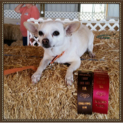 The importance of smell to our canine friends is finally being recognized and used more and more to engage and entertain our dogs. Tracking has long been an AKC venue, but now, just like urban parkour has become popular among city dwelling athletes, urban tracking is a recognized dog sport. Nosework is a growing sport with rules and titles, and Barn Hunt events are becoming popular enough to draw crowds of spectators at dog shows (no rats are hurt in these events…they are mostly pet rats that enjoy the activity).
The importance of smell to our canine friends is finally being recognized and used more and more to engage and entertain our dogs. Tracking has long been an AKC venue, but now, just like urban parkour has become popular among city dwelling athletes, urban tracking is a recognized dog sport. Nosework is a growing sport with rules and titles, and Barn Hunt events are becoming popular enough to draw crowds of spectators at dog shows (no rats are hurt in these events…they are mostly pet rats that enjoy the activity).
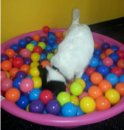 Recognizing the absolute joy with which dogs engage in these endeavors, we have incorporated scent work into our daycare curriculum and the dogs are loving it! We have seen dogs lacking confidenc
Recognizing the absolute joy with which dogs engage in these endeavors, we have incorporated scent work into our daycare curriculum and the dogs are loving it! We have seen dogs lacking confidenc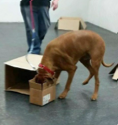 e blossom as they work the room looking for hidden treats in boxes and objects. And because so much of their brain is involved in processing odors,we have found that the dogs are tired in a really good way. Instead of dogs being revved up they seemed relaxed and satisfied after their turn at sniffing their way around the room. We recognize that many of our guests have dietary restrictions so for those dogs we ask that owners bring food that is appropriate for their dog.
e blossom as they work the room looking for hidden treats in boxes and objects. And because so much of their brain is involved in processing odors,we have found that the dogs are tired in a really good way. Instead of dogs being revved up they seemed relaxed and satisfied after their turn at sniffing their way around the room. We recognize that many of our guests have dietary restrictions so for those dogs we ask that owners bring food that is appropriate for their dog.
Scent work – just one more way Sit! Stay! Play! is committed to sending home not just a tired dog, but a better dog!
If you would like to read more about how your dog smells:
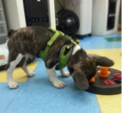 http://www.pbs.org/wgbh/nova/nature/dogs-sense-of-smell.html
http://www.pbs.org/wgbh/nova/nature/dogs-sense-of-smell.html
http://www.uspcak9.com/training/scent.pdf
